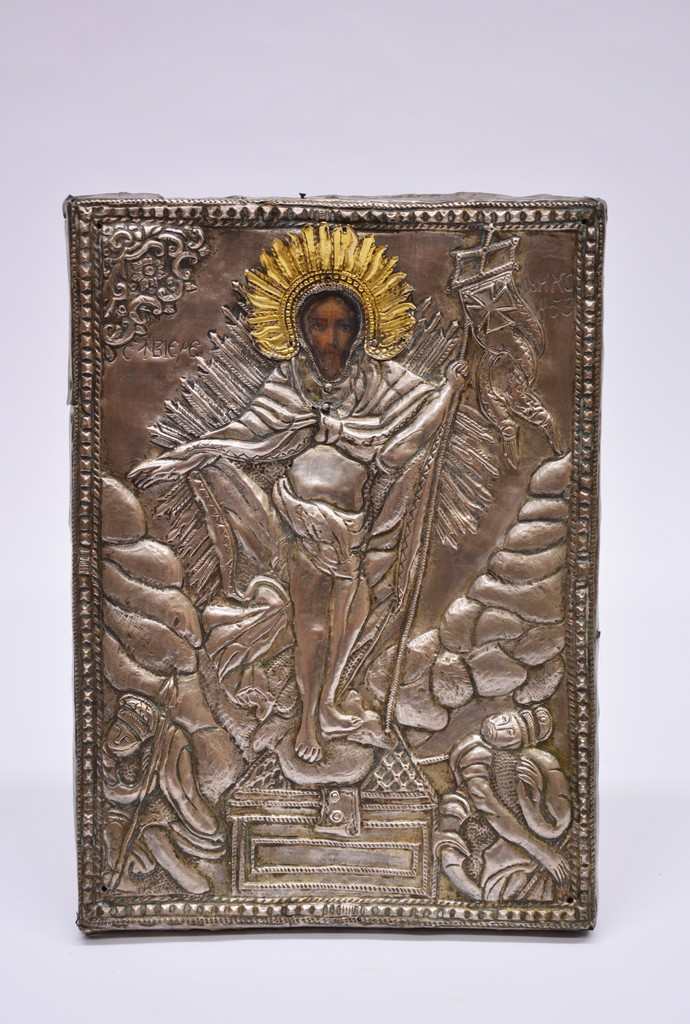  #Exhibit of the Month #Exhibit of the Month
April 2023
“Resurrection of the Lord” icon
 The Paschal icon "Resurrection of the Lord" represents one of the central holidays of Christianity, the subject signifying also one of the great Mysteries. The "Resurrection of the Lord" is the pivotal moment in the history of salvation, Christ the Redeemer raising man and the whole creation closer to God. The resurrection of Christ is the truth on which all Christian teaching is based. The worldview of the first Christians and all early Christian art is permeated by this paschal joy and belief in the triumph of life over death.
The Paschal icon "Resurrection of the Lord" represents one of the central holidays of Christianity, the subject signifying also one of the great Mysteries. The "Resurrection of the Lord" is the pivotal moment in the history of salvation, Christ the Redeemer raising man and the whole creation closer to God. The resurrection of Christ is the truth on which all Christian teaching is based. The worldview of the first Christians and all early Christian art is permeated by this paschal joy and belief in the triumph of life over death. The constitution of the iconography of the "Resurrection of the Lord" celebration presented an extremely difficult task, the very event of Christ's Resurrection being misunderstood. This moment, not being described in the Holy Scripture, remained for the simple man an impenetrable mystery. The silence of the evangelists in this regard testified to the greatness of the event that defied any description, much less representation. Only through the symbol that expresses Christ's victory over death does the mind become able to transcend space and time, to leave the visible world and approach what is hidden from historical evidence. For the artistic embodiment of the mystery of the Resurrection, the Church has over time created a complex language of images, signs and attributes. Such a pictorial formula was developed that revealed the spiritual component of the Resurrection of Christ, embodied the true triumph of Christ as the lord of heaven, conqueror of death and liberator of mankind. According to the Orthodox belief, in the three days between His death and resurrection, Christ descended into hell, to free the souls imprisoned in that place, this is why the classic icon of Orthodox origin was entitled "The Descent of Christ the Savior into Hell". In these images, Christ does not appear in a humble, vanquished attitude, but in one of the conqueror of death, the savior of those defeated by death. Western tradition has introduced into liturgical use other images, more understandable for the layman's consciousness, in which the Risen Christ can be represented above the tomb, the sarcophagus, sometimes alongside the women bearing myrrh. These images distance themselves from the stated symbolism and are included among the images that chronicle the evangelical events. The icon from the museum's collection devoted to this subject presents a silver-plated brass ironwork using the hammering technique, the decorative elements being modeled in relief and engraved in depth. The composition is framed in a border made up of three columns: the central column being made of small pyramids viewed from above, the side ones decorated with the so-called "twisted rope" ornament. The veil almost completely covers the field of the icon, leaving only the Savior's face visible. Jesus Christ is represented triumphant over death, stepping over the closed sarcophagus. He is draped in a broad mantle fastened to the breast by a brooch, his right hand extended to his side, his left holding the banner with a cross inscribed in it. The haloed Christ is framed in a radiated rhomboidal mandorla. On one side and the other - split stones, which testify to the passages described in the Gospel - "the earth shook and the stones split" - at the moment of Christ's death (Matthew 27, 51). The cracking of the stones could also recall the opening of the waters of the Red Sea, mentioned in the Old Testament, about the people of Israel who left the slavery of Egypt, to go to the land of promise. On one side and the other of the sarcophagus - two Roman soldiers, among those guarding the tomb, blinded by the light emitted by the resurrected Christ. Bessarabia, 1853
Wood, oil, silvered brass, gilding, 30×21 cm
Inventory 24158, purchase, Chisinau, 2003
|




















































